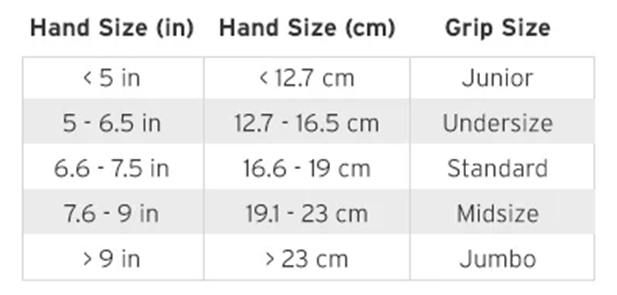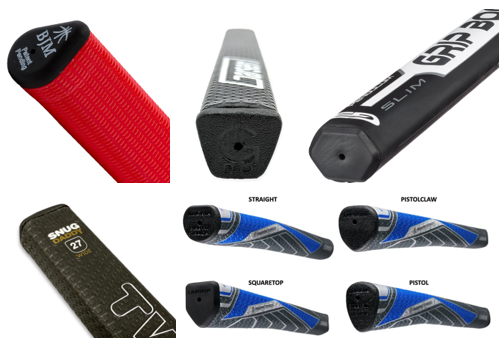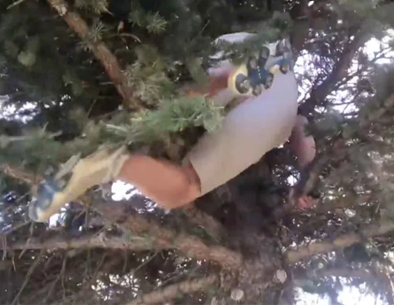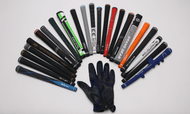Golf Grips: Everything to know, and then some
Posted by Colin on May 02, 2024
In order to rip it, one must first grip it. -Sun Tzu
Classic Tzu, the guy was able to boil down the most complex situations to their basest elements. And here again he is correct, if you want to hit the ball well, it all starts with the grip. You may think you know everything there is to know about grips, but you don't. Hold onto your potatoes because you're in for 'gripstravaganza' knowledge explosion. And one last note before we dive in, there isn't any record of Sun Tzu saying that, but there's a chance he said it in passing. Between devising wartime strategy and wistfully contemplating the meaning of life amongst the cherry blossoms, nobody can really be sure he wasn't dreaming of ripping a 340-yard laser beam off number 1. Sure, he lived around 500 BC and golf wasn't "invented" until around 1400 (some would argue ~1300, more on that later) but are you going to question a guy who wrote a manuscript 2500 years ago that is still read today, that maybe he was ahead of his time? Not me, I'm definitely open to the possibility of Tzu thinking about futuristic leisure activities in his spare time.

A (brief) history of the golf
The history of the grip coincides with the game itself and the game itself has its origins debated. There are records from 1297 of a game being played in the Netherlands that has similarities to golf where a stick was used to hit a ball into a hole hundreds of yards away and the goal was to get it done in the fewest number of whacks. In 1360, the council of Brussels banned “colf”, apparently if you got caught playing you had to pay a fine of 20 shillings or give the authorities your coat. I didn’t research an equivalent of 20 shillings in 1360 to today, but a coat in 1360 seems like a heck of a price to pay. By my estimation a coat in 1360 is like a car today, maybe… Let’s disagree and say there hasn’t been any “coat inflation” if somebody were to take my coat on a cold day, well, then I’d be cold, and that would be disappointing. Tough nuts if you just wanted to play a round with your boys, Brussels wasn’t having no “colf” shenanigans. There are about ten other early records of golf or something similar but none as notable as the coat snatchers of Brussels, although a couple of them did involve deaths.
While several records of golf adjacent games predate the records in Scotland, it’s widely held that golf was invented in Scotland. Why? Short answer: The spokesman for the Royal and Ancient Golf Club says so. “Stick and ball games have been around for many centuries, but golf as we know it today, played over 18 holes, clearly originated in Scotland.” His words. So that, as they say, is that.
Was it necessary to learn about the history of golf to adequately understand the evolution of the grip? Not really, but it does give some context and I spent too much time researching it to not write about it.
Evolution of the grip
I hope you’ve stuck with me thus far because this is what
you came for, the history and evolution of the golf grip. The clubs, or rather,
the sticks that were used in the nascent years of golf didn’t have grips on
them. Turns out the old Scots were raw dogging their clubs. The problem with
going raw is obvious, it gets slippery. There
were several ways the slippage was combatted. There is evidence that gloves
were used, some clubs are found with notches and/or grooves where the golfers’
fingers would be placed, and lastly pine tar or some other sticky agent was
employed. All effective but gloves were expensive and probably weren’t skintight
like the modern equivalent, so the feel was probably awful, slippery grooves
are still slippery, and sticky fingers aren’t pleasant. They made do with what
they had, but the Scots were an inventive bunch and they figured there had to
be a better way. One thing the Scots had in abundance, sheep. They used sheep
skin for all sorts of other things, so in a stroke of genius, the sheepskin was
made into strips and wrapped around the handles. With Shaemus gloating around
the 19th hole with his sheepskin wrapped club, it wasn’t long before
Flaherty, O’Houlihan, and the rest of the gang got on board and ditched the
pitch. William Wallace wasn’t impressed though; he knew it could be even
better. He wrapped the butt with some tattered fabric from his tunic and then
he wrapped all of that up with sheepskin. Hoooooo Booooyy, we got a flared
base! The flared base was only thing people could talk about at the following
Highland Games. Between the Caber Toss and the Haggis hurling, all the chatter
was about Wallace and his flared base.
abundance, sheep. They used sheep
skin for all sorts of other things, so in a stroke of genius, the sheepskin was
made into strips and wrapped around the handles. With Shaemus gloating around
the 19th hole with his sheepskin wrapped club, it wasn’t long before
Flaherty, O’Houlihan, and the rest of the gang got on board and ditched the
pitch. William Wallace wasn’t impressed though; he knew it could be even
better. He wrapped the butt with some tattered fabric from his tunic and then
he wrapped all of that up with sheepskin. Hoooooo Booooyy, we got a flared
base! The flared base was only thing people could talk about at the following
Highland Games. Between the Caber Toss and the Haggis hurling, all the chatter
was about Wallace and his flared base.
The flared base stood at the peak of golf grip innovation for a very long time before it was supplanted. Over the next couple hundred years different animal hides were dried and tried and affixing the various leathers to the club went through iterations of sticky substances or nail variations but it wasn’t until the 1950’s that grips took the next major step forward. In 1949, Golf Pride was founded when Thomas L. Fawick had the grand idea of using rubber instead of leather. The rubber was a massive leap forward in feel and durability, but it also weighed less, absorbed shock better, and was a whole lot grippier than its’ leather counterpart. But Golf Pride didn’t just stop innovating when they came out with the rubber grips. A mere 4 years later, in 1953, they made grips that could slip on and off. It might not seem like a big deal (it didn’t to me) but it turns out, that was a major breakthrough at the time. It changed the whole business of golf club manufacturing. No longer were the folks who made golf clubs also responsible for making the grips, because the grips didn’t have to be manufactured directly onto the shaft anymore, outsource baby outsource. And with the slip-on grip being so simple, golf shops started carrying the tools to do grip changes right at the course. As it turns out the invention of the slip-on grip coincided with another innovation in grips. The cord grip. Essentially, cotton or synthetic fibers were placed in a mold, then rubber was injected into the mold to get a fibrous rubber composite. When the mold cooled, the grip is removed and sanded down to reveal more of the fibrous strands. The idea is to create a firm grip with harder rubber and the fibers that poke through allow you to get a grip with no slip. Neat, I spent nearly two hours researching the cord grip to give you those two sentences…. I’m sorry, I didn’t realize the cord omission until I was nearly finished, and I hate going back to rewrite things, but I couldn’t leave it undone. I hope what you learned about cord grips was invigorating. Onwards!
From the advent of the rubber grip in the 1950’s to today, aside from the hybridization of cord and rubber grips, the innovations have been more subtle. The rubber has undergone changes to make it more durable, more comfortable, more grippy, and the grips overall went through design changes to make them more appealing (the early victory green cords were beauties.) But by and large the rubber grip today is still just a rubber grip. What is notable is that grips have become more segmented. There is a grip for every occasion and for every player. Grips for small hands, grips for big hands. Grips for wet weather and grips for dry weather. Grips that are squishy, and grips that are firm. They even make grips for people with arthritis, and that is pretty great. From gripping grain to gripping rubber, now you know every major change that the golf gripping industry has gone through, every single detail and 100% accuracy.
*100% accuracy is likely not 100% accurate, if I left something out, let me know in the comments.
** Attribution to Scottish individuals responsible for innovations are inferred based on probabilistic algorithms for Scottish names from the 1500’s.
Grip Distinctions
Swing grip vs putter grip.
A swing grip is a grip that goes on to anything besides a putter. A club that you swing, if you will. A putter grip goes on to a putter. The club you putt with. If you want information on putter grips, jump ahead a few sections to putter grips.
Material
- “In the evolution of putter grips section, you outlined
how far grips have come to get rubber grips and said that’s when the innovation
stopped, only to go forward a few sections and find out rubber grips aren’t the
only option?” -You, probably. “Not exactly. Or maybe. I got tired of writing
and while I could just go up and add in a few sentences about cord grips and
hybrids, I don’t really feel like it. Suffice to say, cord grips came out some
time after rubber grips were invented. They have some fibers mixed into the
rubber for a firmer feel while maintaining friction.” -Me.
When the manufacturers reference materials they are primarily talking about rubber grips, cord grips, and hybrid grips which are part rubber, part cord. Some companies still make leather grips and some work with polymers.
-Rubber grips tend to be softer. They dampen the shock felt on bad shots, which is nice, but it also means you have less feedback from shots in your hands. They do a good job of not retaining moisture, whether that be from your body or in the air, so they retain grippiness in all weather conditions. Rubber grips are preferred by amateur golfers due to mainly to shock absorption and because they don’t need to be replaced as often as other grips.
-Cord grips are firm. The firmer the grip, the more you will feel your shot. That’s great if you are a consistent ball striker. The cord grips are the fastest way to develop calluses on your hands if you’re into that sort of thing. They will chew your hands up if you’re a softie and didn’t bring a glove. Cord grips have great grippiness in dry conditions but can be challenging to hold onto in wet conditions because the fibers soak up the moisture. I did read a post on forum from a guy in Australia that said he always has a square of sandpaper in his bag that he rubs on his cord grips when they get wet, and he says that it works great to get them grippy in wet conditions. I have no idea if that is good advice, but it is advice. Cord grips are preferred by good golfers who are also masochists. Just kidding, they are great if you want all the feedback in your hands and you want to look like a professional golfer.
-Hybrid grips are an amalgamation of both rubber and cord grips. They attempt to find a balance of squish and firm to lessen the sting of really bad shots but also get some feedback on the shots that are intentionally off-center or glancing blows. The corded section grips in dry conditions and the rubber section grips in wet conditions. Hybrid grips are used at all levels of golf and are a good option regardless of skill or conditions.
-Leather grips still have a place on golf clubs. The leather grips produced today by WINN or Lamkin are nothing like their rudimentary predecessors. They provide comfort and feel, and leather naturally repels water. The downside is that they have to be replaced more frequently than rubber and they are also more expensive, generally. The huge plus side is that the soft feel combats hand fatigue and opens the game up to arthritis sufferers. Leather grips are great for folks with sensitive digits or if you just want to feel like holding onto something nice.
-Polymer and other material grips are neat because they are different. The companies testing out alternatives should be applauded. From wood, to leather, to rubber, what is going to be next? If it feels good and performs well under all conditions, it could be worth giving it a try.
Size
Manufacturers call different sizes different names, and even if they do use the same name the sizes aren’t necessarily the same. But primarily, there are four sizes: undersize, standard, midsize, and jumbo. You can also find jumbo max which are even bigger, but those grips are only for the freaks (the only guy I know that uses this size also drives the ball about 350 yards, freak indeed). Junior size grips are usually smaller in circumference, they have a smaller length, and they also have a smaller opening to better fit on the smaller shafts of the smaller junior clubs.
Really whatever feels good in your hand is probably an appropriate size. The prevailing thought on performance is that a large grip will take your hands more out of the swing while a smaller grip will allow you to get more handsy. But if you want some guidance to figure out the “proper” grip size, you are supposed to measure your flat hand from wrist to the tip of your middle finger and then use this chart to see where you fall.

Putter Grips
Brother, if you find the one that works, tell me. I am sure there is scientific research that influenced the designs onsome of the putter grips that are circulating. But I am led to believe that a good handful came from shapes floating in the designer’s fever dream. In reality each grip shape and size probably serves a purpose, but I don’t believe that there is a “correct” putter grip, it just comes down to preference. The best way to figure it out is to go to a golf shop or sporting goods store that has a large putting green surrounded by putters that you can test out. It doesn’t matter what putter the grip is attached to, try to focus on how the grip feels in your hand and see if you’re able to create a consistent stroke that you can replicate without discomfort.

You thought we were finished?
When I said this blog would have everything about grips, did you think I was joking? I wasn’t, we are just getting into third gear. We still need to talk about gloves, and gripping grips, and ripping and regripping grips. Post-haste, forthwith, on with the show!
Gloves
If the glove doesn’t fit, you must equip. I can’t talk about grips without talking about gloves. If you live in a wet climate, or you sweat as much as I do (it’s a lot, like more than anyone I know, and I know a lot of people), you need to wear a glove. It doesn’t matter how much you spend on grips that assure you they don’t slip even under the most adverse conditions, those assurances are built on a foundation of lies. Take it from a guy who has had to climb up tree 40 feet to retrieve a pitching wedge, wear a glove. What if I fell from that tree? What if you don’t wear a glove and your club slips and you are the one having to climb a tree? Ipso facto, gloves save lives. That’s not a picture of me, but that is what I looked like.

One other
thing, golfers wear one glove. You wear the glove on the hand that is higher on
the grip. If you wear two gloves, you are excellent. Personally, I like your
style, but prepare yourself for ridicule from lesser men. What do Aaron Rai,
Tommy “Two-gloves” Gainey, and Rex Kwon Do have in common? They are men that do
man things at the highest level and look great doing it. So what do you do if
someone comes at you while you have on two gloves? Break the wrist and walk
away. Three things I learned from taking Rex’s eight week class. First off, use
the buddy system. No more flyin’ solo. You need somebody watching your back at
all times! Second off, I learned to discipline my image, you can’t get anywhere
in life dressed like Peter Pan. Nobody wants a backhand slap to the face if you’re
wearing two gloves. Lastly I learned about self-respect. Nobody would think I’m
a failure if I went home to Starla every night. Forget about it. Now bow to
your sensei.
the highest level and look great doing it. So what do you do if
someone comes at you while you have on two gloves? Break the wrist and walk
away. Three things I learned from taking Rex’s eight week class. First off, use
the buddy system. No more flyin’ solo. You need somebody watching your back at
all times! Second off, I learned to discipline my image, you can’t get anywhere
in life dressed like Peter Pan. Nobody wants a backhand slap to the face if you’re
wearing two gloves. Lastly I learned about self-respect. Nobody would think I’m
a failure if I went home to Starla every night. Forget about it. Now bow to
your sensei.
Gripping the Grip
This is where you learn how to hold the club. There are two grips that lend themselves to the most successful golf swings; interlock and overlap. An interlock grip can give you better control over the golf club, it feels tighter and more stable which may allow you to swing faster and still feel in control. An overlap grip is better for folks with big hands. If you feel like there isn’t enough room to lock your pinky around your forefinger, it might be time for a switch. Also if you want to loosen your grip on the golf club because you have a tendency to put the club in a vice grip, maybe look at overlap. To adequately learn about positioning your hands on a golf club, a blog won’t cut it. But don’t leave yet, go to youtubes on your own time later.
Ripping and Re-gripping
Last item. You want to switch your grips because you learned something about grips that piqued your interest? I’m flattered. Here’s what you’re going to need to get your old grips off and put new grips on.
Tools and Supplies
- Razor, sharp knife, or hook blade
- Double sided tape
- Mineral spirits (putting it in a spray bottle makes clean up easy)
- Mounted vice grip (have a towel between the clamps and golf shaft when you tighten the grip so that you don’t scrape the shaft)
- New grips
Steps
- 1.Put the club in a vice. The face of the club should be square to left or right depending on lefty or righty clubs. (Right-handed clubs should squarely be aiming left)
- a.Squaring the face isn’t important while removing grips but if you are going to put a new grip on, it’s easier to just do it now.
- 2.Carefully remove the old grip off your club with a razor
- a.Ideally you clamp the club in a vice grip and push the razor against the shaft away from your body.
- b.If you are replacing a grip on a club with a graphite shaft be careful to not cut into the shaft.
- 3.Once the grip is fully removed take off as much of the old tape as you can
- a.It doesn’t need to be perfect, just get the big stuff or the parts that are already peeling up.
- 4.Put double sided tape on top of the old tape.
- a.It doesn’t need to cover all the way to where the grip would end
- b.And I like to go about a quarter to a half inch over the butt of shaft and tear the tape there, the part that overhangs I twist it and push it down the inside of the shaft.
- 5.Make sure the club is still square, with the toe pointing up.
- 6.Squirt or pour mineral spirits into the new grip while you have a thumb over the pin hole at the end of the grip. Spray or pour mineral spirits on the double sided tape. Put the spirits down, cover the end of grip with your other thumb, and give it a shake to coat the inside of the new grip with the spirits you already put in there. Pour the excess spirits out of the grip on to the tape.
- 7.Align the grip with the squared club head and push it on while the tape is still wet.
- a.Get it all the way on, and do it quickly.
- b.If the tape dried out or there wasn’t enough spirits to make it slick enough to put on in the first place, pull the grip off and restart at step 3.
- c.If the grip doesn’t have an alignment feature, decide if you want the grip logo facing towards or away from you when you hold the club. It doesn’t matter which way it faces, it just comes down to preference.
- 8.Take the club out of the vice and let it dry standing up with the grip on the ground and the club head in the air
- a.If you went light when applying the mineral spirits this isn’t as important but if you poured the spirits instead of spraying it on, you don’t want all that stuff settling inside the shaft or running down the outside of the shaft. So make sure it's upside down while drying.
The End
If you read this entire thing and already knew everything well la-di-da, look at you. That’s actually pretty impressive. If you did learn something, that’s nice too. In my next golf guide to everything we are going to dig into agronomy. I figure that will be a short one, not too much depth in that topic, mostly topsoil. Ba-dum tsss.
“Don’t be dismayed at goodbyes. A farewell is necessary before you can meet again. And meeting again, after moments or lifetimes, is certain for those who are friends.” –Richard Bach
Auf wiedersehen!

